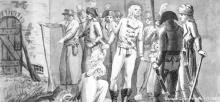In this introductory essay to the special issue of German Life and Letters, guest editors Ellwood Wiggins and Martin Wagner explain the motivations for exploring the Sturm und Drang in the context of Jonathan Israel’s binary of radical and moderate Enlightenment.
Jonathan Israel’s provocative thesis that the European Enlightenment can be divided into two clearly distinguishable camps—one moderate and one radical—has received significant critical discussion, most recently with a specific focus on the tenability of this claim for the German tradition. Although Israel himself places most German thinkers in the moderate camp, his designations are contested and the situation in eighteenth-century German-speaking lands is quite complex (see Radical Enlightenment in Germany: A Cultural Perspective, ed. Carl Niekerk, Brill, 2018). Surprisingly, however, these discussions have not yet taken into account Germany’s most iconic literary movement of the eighteenth century, the Sturm und Drang. Attending to the Sturm und Drang in probing Israel’s dichotomy is important not only to close a gap in the historiography of the European Enlightenment, but also because it allows to situate and discuss some of the characteristic interior tensions of the Sturm und Drang within a framework relevant to the European Enlightenment more broadly. For the Sturm und Drang is characterized both by radical gestures of formal transgression against neoclassical tendencies in German art and, with some important exceptions, a surprising degree of political moderation. How is it that some of Germany's most radical iconoclasts in artistic form seem to be moderate or even reactionary in their politics?
This introductory essay explores this question through Goethe's reception of Spinoza and by reading two underappreciated mini-dramas by Johann Anton Leisewitz. It conclude with an overview of the articles collected in the present volume to suggest how they further develop, comment on, or challenge the binary of radicality and moderation in the Sturm und Drang.
